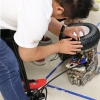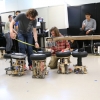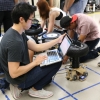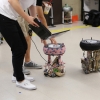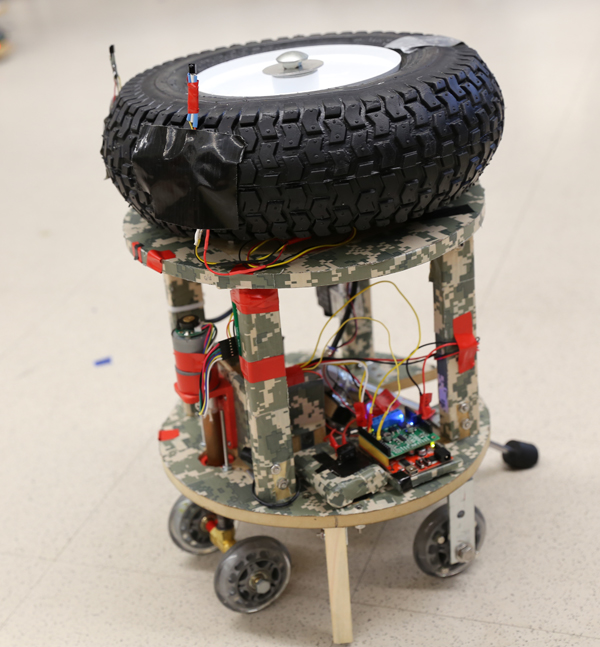
June 25, 2015 – The robots looked like a cross between toys from an Erector Set and bumper cars, but to the mechanical and aerospace engineering students in MAE 106, this was no game.
Teams of four had custom-built the robots to race across a 20-by-26-foot course toward an infrared light beacon. From a starting field of 62 robots, 16 preliminary-round survivors were geared up to duke it out on Monday, June 8. The stakes were high; winners would receive up to 14 percentage points of extra credit toward their final grade.
As a course requirement, the third-year engineering students had to design, build and program a robot controlled by an Arduino-based microcontroller. The robot had to propel itself with actuation from a pneumatic cylinder, and steer itself with a direct-current motor.
“This is important because it’s a hands-on project, not just theory and looking at formulas,” said postdoc Jaime Duarte, who is teaching the class while professor David Reinkensmeyer is on sabbatical. “They’re actually building something.”
The robots raced in groups of eight. After the starting whistle, they had to wait 15 seconds while the beacon – four infrared-emitting LED lights at 90-degree intervals – was suspended above the course. This last-minute placement prevented students from just “pointing and shooting,” Duarte said, instead forcing them to rely on sensors to guide the robots.
This was no simple race to the finish. The robots, each with a tire affixed to its body like a crown, bumped into and against each other, shoving their way to the beacon. “Part of it is making the robot stable enough to not be knocked over,” Duarte said. “Sometimes a robot will get to the beacon very fast but then another one will come and push it out of the way.”
Forty-five heart-pounding seconds later, all robots were stopped, and measurements were taken. Points were awarded based on robots’ proximity to the beacon; the winning team was chosen based on cumulative results from eight heats.
“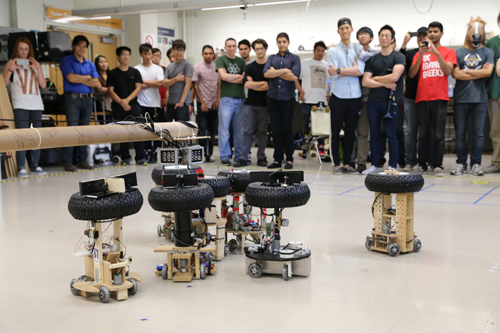 We were neck-in-neck with the second-place team, but we took it over theirs in the final round,” said team member Derek Kuey, whose team ended up winning by just five points. In their closest round, the robot stopped a mere two inches from the beacon.
We were neck-in-neck with the second-place team, but we took it over theirs in the final round,” said team member Derek Kuey, whose team ended up winning by just five points. In their closest round, the robot stopped a mere two inches from the beacon.
“Our robot was a complete last-minute mess,” admits team member Chris Lan. “The best part was that our wire-dangling, wood-splitting, leisurely moving robot actually beat all the other 50-plus slick-looking, fast and furious transformer-like robots.”
For most of the participating students, the 10 weeks they spent building the robots was their first experience with hands-on design and construction. The Samueli School’s freshman experiential learning class launched after they had already completed their freshman year, so there were lots of lessons to be learned. “Most of these kids had no idea how to solder, how to build anything,” Duarte said. “Now they have some experience. It prepares them well.”
The participants concur. “What I enjoyed most about building the robot is the fact that we as a team got to see the progression of it from scratch to something that can maneuver around a designated course,” said Pei Chi Wu, the winning team captain. “Also during the competition, we realized that strategy was important, so coming up with strategies to outthink our opponents was challenging but it was entertaining.”
Duarte said he was satisfied with the class’s outcome. “We were very happy with the results this year; about 90 percent of the groups [created a robot] that was doing what it was supposed to do. It was a lot of work but also a lot of fun.”
-- Anna Lynn Spitzer; photos, Debbie Morales

